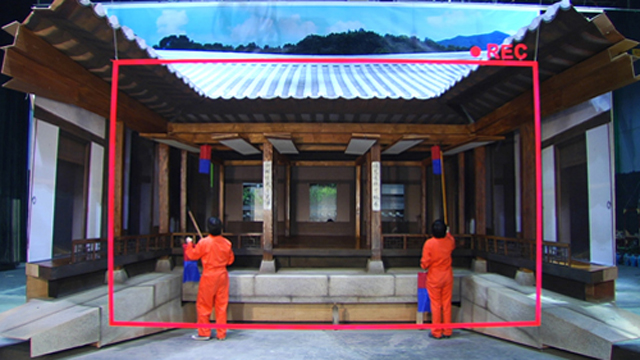Thanks to Stumble Upon I just came across the work of Yeondoo Jung, a Korean artist who works mainly with photography, video and installation. The pieces I looked at first were part of Wonderland – a series of photographs from 2004, where Jung took a selection of 1000 childrens’ drawings and recreated them in full color using sets, props and actors. This image is called ‘The Magician turned the Whale into a Flower’:
I really like Jung’s interpretation, with all that pink madness, but I love the original drawing even more so, with it’s bright green carpet of grass and its beautiful title in a lively Korean script.
Intrigued to see more of Jung’s work, I visited his site and found Handmade Memories (2008), an installation of 6 pairs of video monitors and some photographs. The right hand screen of each video pair showed an interview with a stranger – 6 elderly people who’d all lived through the Japanese occupation of Korea, recalling a memory linked to a specific place, such as a barley field, a railroad or a beach. Jung opens each interview with the statement “What is the most memorable experience of your life?”…

Barley Field, from Handmade Memories, 2008
Meanwhile, on the left hand screen a team of stagehands, in a single orchestrated take, beginning with an empty stage, go about setting up a backdrop, scenery and props to recreate these settings – a synthetic rendition of an imagined world.

6×6 Manor, from Handmade Memories, 2008
In the case of the beach scene, this involved two trucks dumping full loads of sand onto the stage, followed by a hydraulic excavator spreading it out, then a team of workers with shovels installing a plastic blue pond and palm trees, then a live camel taking its place in the ‘perfect’ island beach scene. The story being told alongside this picture is of a promise made by a boyfriend ‘to take me to Jenju Island to ride camels and take pictures’, a promise which seems less and less likely to be fulfilled as the story unfolds, while the scene itself becomes more and more ‘real’…

Jenju Island Camel, from Handmade Memories, 2008
Looking at Jung’s work has triggered lots of questions for me – what is it about these staged, superreal scenes that I like or find interesting? How does this relate to my work, non-narrative, meditative work which on the surface seems totally unconnected?
There’s a definite fascination here, especially after interviewing Winifred Whitfield and looking at her idealised, staged portraits last month. It also echoes with one of my favourite films – ‘This Life Aquatic’, which has a deliberately staged and over-the-top style in its art direction. Plus it has the same dark comedy underlying the super-colorful images, costumes and sets. In fact, Jung’s use of the techniques and ‘tricks’ of filmaking and slick advertising images is an aspect of his work that most resonates with me (I worked in special effects post-production and frame-by-frame retouching for TV and film in a previous life!).
Jung’s blend of reality and fantasy is the fascinating thing – in coaching, I’ve learned that we are all responsible for our own reality. Ultimately, we are in charge – of both our perception of our own reality and also of how we respond emotionally to it. We can decide what’s in and what’s out, how joyful or sad it is for us, how ‘normal’ or different it is… So, how much fun is it to genuinely play with these borders and boundaries? To create whatever we want, new worlds, new possibilities. And also to reinvent and reinterpret the past – to change the story and so change the way you feel about it – to transcend reality…

Legend and Poverty, from Handmade Memories, 2008
So, who knows what ideas this work will provoke in my process or in my coaching, where I combine visual tools with traditional coaching tools when I’m working with my clients… but I look forward to seeing more of Jung’s work as it unfolds. I hope you do too.
To read the article on Recreating Children’s Drawings on DesignBoom click here
or just do an image search on Google to see more of Jung’s work.
